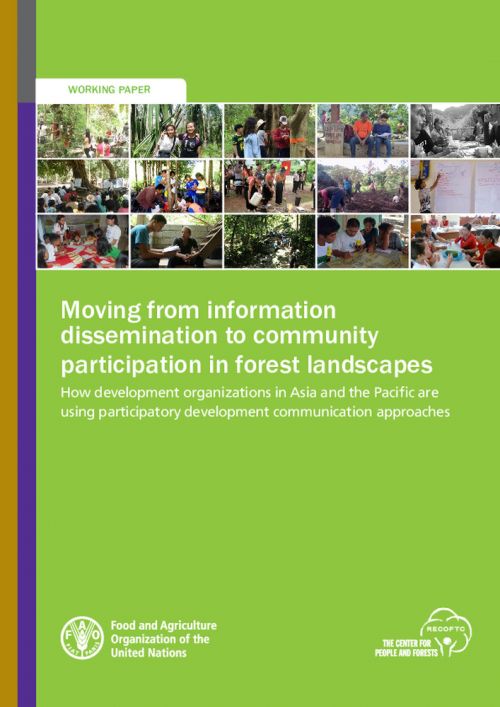APA 6th ed. Moving from information dissemination to community participation in forest landscapes. (2017, August 1). Retrieved from https://www.recoftc.org/publications/0000321
MLA 8th ed. Moving from information dissemination to community participation in forest landscapes. RECOFTC, 1 August 2017, https://www.recoftc.org/publications/0000321.
Chicago 17th ed. RECOFTC. 2017. "Moving from information dissemination to community participation in forest landscapes." Published August 1, 2017. https://www.recoftc.org/publications/0000321.
Moving from information dissemination to community participation in forest landscapes

Traditionally, in the context of environment and natural resources management, many communication efforts have focused on the dissemination of technical information to end-users who were expected to adopt them. Development practitioners were trying to ‘push’ their products on communities in order to receive community commitment to their development initiatives. Further, when planning communication strategies, many projects tend to take a very broad problem as a starting point (a declining forest, for example) and then move right into planning communication activities (for example, information sessions, awareness campaigns). The result is that the target is often missed and despite all the activities undertaken the problem remains unaddressed.
Participatory development communication (PDC) takes a different approach. It suggests a shift in focus from informing people with a view to changing their behaviours or attitudes to facilitating exchanges between various stakeholders. These exchanges help the stakeholders to address a common problem or implement a joint development initiative.
PDC is a systematic process using participatory techniques and communication media (such as radio, newspapers, TV, social media) to empower communities to participate in the development process, enable them to take the lead on its activities and use the learning generated to improve their livelihoods. The purpose of PDC is to seek sustainable social change by engaging and empowering relevant stakeholders (FAO, 2014). At the heart of PDC and other participatory research and development approaches is people’s meaningful participation and empowerment.
This paper offers a brief overview of the basic and practical steps involved in the PDC process to assist sustainable forest practitioners and communication officers to adopt a PDC approach in their work. The paper then reviews the PDC components of six case studies promoting sustainable forest management in Asia and the Pacific. Each project was conducted in 2015–16 and included a primary objective of influencing ‘community awareness and attitudes’ towards sustainable forest management.
While the case studies do not offer examples of the complete PDC approach, they highlight how sustainable forest management projects in the Asia-Pacific region are moving away from one-way information dissemination toward using two-way communication approaches and tools to promote community participation in forest decision-making.
The case studies were developed following a joint RECOFTC and FAO workshop on 12–15 May 2015 to improve the capacities of forestry communication officers from governments and NGOs to plan, develop and facilitate participatory development processes in building and implementing more effective communication strategies. Workshop participants are members of the Asia-Pacific Forest Communication Network (APFCN).

